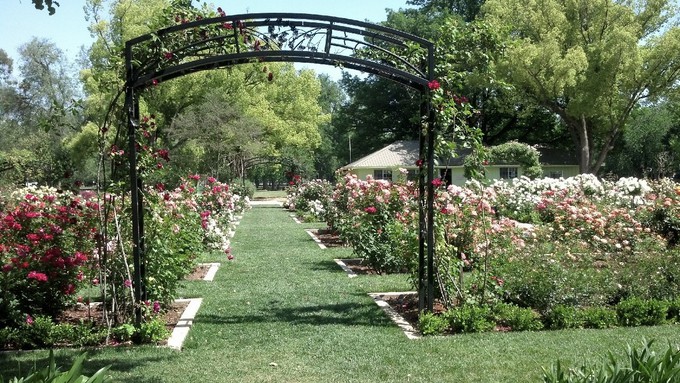
More pruning events set for Saturdays throughout January

This is what the McKinley Park Memorial Rose Garden will look like come spring. But first, all those rose bushes require pruning -- by volunteers. Debbie Arrington
Love to prune? Want to learn? McKinley Park’s famous Memorial Rose Garden is the place to be.
Volunteers are needed to finish pruning the beloved garden’s 1,200 roses – then maintain the roses through spring and summer.
No advance registration is needed. Just show up with thorn-resistant gloves, closed-toe shoes and maybe rain gear; these events are rain or shine.
Pruning sessions will start at 8:30 a.m. every Saturday in January plus Feb. 10 and 17. In addition, the pruning crew will be out at 8:30 Wednesday, Jan. 17. After a morning of pruning, the volunteers are provided lunch.
“Volunteers should plan to meet at the Rose Garden,” say the organizers. “Tools, gloves and instruction will be provided. Please dress appropriately for working outdoors, including closed-toe shoes.”
On the south edge of McKinley Park, the Frederick N. Evans Memorial Rose Garden – named for Sacramento’s first parks superintendent – is located on H Street between Alhambra Boulevard and 33rd Street in East Sacramento. Originally planted in 1929, the rose garden replaced what was a running track (hence its oblong shape). In 2012, the bushes were almost entirely replaced with newer, disease-resistant varieties.
For the pruning events, volunteers are asked to assemble at the park’s Rose Garden Room, the small structure located on the north side of the garden. The sessions are expected to last until 11:30 a.m. each day.
McKinley Park's rose garden also needs volunteers to help maintain the bushes throughout their blooming season.
Questions? Email sacrecreation@cityofsacramento.org or rosegardenvolunteer@cityofsacramento.org.
Comments
0 comments have been posted.Sacramento Digs Gardening to your inbox.
Food in My Back Yard Series
May 6: Maintain soil moisture with mulch for garden success
April 29: What's (already) wrong with my tomato plants?
April 22: Should you stock up on fertilizer? (Yes!)
April 15: Grow culinary herbs in containers
April 8: When to plant summer vegetables
April 1: Don't be fooled by these garden myths
March 25: Fertilizer tips: How to 'feed' your vegetables for healthy growth
March 18: Time to give vegetable seedlings some more space
March 11: Ways to win the fight against weeds
March 4: Potatoes from the garden
Feb. 25: Plant a fruit tree now -- for later
Feb. 18: How to squeeze more food into less space
Feb. 11: When to plant? Consider staggering your transplants
Feb. 4: Starting in seed starting
Sites We Like
Garden Checklist for week of May 11
Make the most of the lower temperatures early in the week. We’ll be back in the 80s by Thursday.
* Plant, plant, plant! It’s prime planting season in the Sacramento area. Time to set out those tomato transplants along with peppers and eggplants. Pinch off any flowers on new transplants to make them concentrate on establishing roots instead of setting premature fruit.
* Direct-seed melons, cucumbers, summer squash, corn, radishes, pumpkins and annual herbs such as basil.
* Harvest cabbage, lettuce, peas and green onions.
* In the flower garden, direct-seed sunflowers, cosmos, salvia, zinnias, marigolds, celosia and asters. (You also can transplant seedlings for many of the same flowers.)
* Plant dahlia tubers.
* Transplant petunias, marigolds and perennial flowers such as astilbe, columbine, coneflowers, coreopsis, dahlias, rudbeckia and verbena.
* Keep an eye out for slugs, snails, earwigs and aphids that want to dine on tender new growth.
* Feed summer bloomers with a balanced fertilizer.
* For continued bloom, cut off spent flowers on roses as well as other flowering plants.
* Add mulch to the garden to maintain moisture. Mulch also cuts down on weeds. But don’t let it mound around the stems or trunks of trees or shrubs. Leave about a 6-inch-to-1-foot circle to avoid crown rot or other problems.
* Remember to weed! Pull those nasties before they set seed.
* Water early in the day and keep seedlings evenly moist.